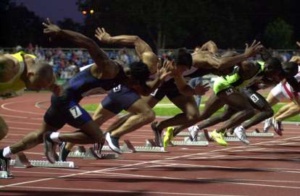 The difference between the winner and loser in a race, fight, or game usually boils down to one fitness quality: rate of force development (RFD). This is a measure of how quickly you can reach peak levels of force. The guy who can land a roundhouse kick or explode off the line or elevate for a jump shot first is the dominant force.
The difference between the winner and loser in a race, fight, or game usually boils down to one fitness quality: rate of force development (RFD). This is a measure of how quickly you can reach peak levels of force. The guy who can land a roundhouse kick or explode off the line or elevate for a jump shot first is the dominant force.
It works the opposite way, too.
When an aging athlete is trying to hang onto his illustrious career, you’ll never hear a commentator say, “Well, he’s faster than he used to be but he’s no longer at the top of his game.” Quickness and athletic proficiency go hand-in-hand. There’s a reason why 42 year-old athletes aren’t breaking world records in the 100 meter or winning a slam dunk contest. It’s because their RFD has diminished. Every power sport you could possibly think of hinges on your ability to produce high levels of force at the flip of a switch.
So as a performance trainer I’m most concerned with how my power athletes improve their broad jump score since it’s one of the simplest and most effective ways to measure RFD.

But jacking up your RFD does more than just improve your jump. Indeed, enhancing your RFD can help you build more muscle, too. We all know that adding load or speed to the barbell will upregulate protein synthesis. What’s often overlooked is that lifting heavier or faster requires you to tap into your force-producing capacity quicker than before.
Now, for the essential question. How do you improve RFD?
Research demonstrates three separate ways. First, and most obvious, is through explosive strength training with a submaximal load (Newton et al, Med Sci Sports Exerc 1999). So you’ll start with a load you could lift, say, 10 times but only do three super fast reps. The second scientific way to boost RFD is through maximal strength training with a heavy load and low reps (McBride et al, J Strength Cond Res 2002). The third way to improve RFD is the one that’ll surprise you most.
In physical rehabilitation settings it’s common for physical therapists to prescribe balancing exercises to retrain muscle firing patterns after an injury. These exercises such as standing on one leg on a wobble board are known as sensorimotor training (SMT). Therapists knew it helped patients regain their balance, but it wasn’t until research dug deeper into SMT that another surprising benefit surfaced: balance exercises improve RFD (Gruber & Gollhofer, Eur J Appl Physiol 2004).
So I started experimenting with different combinations of explosive strength, maximal strength, and sensorimotor training. My goal, of course, was to enhance their RFD as primarily determined by an increase in their broad jump.
I found two different sequences that produced outstanding results. The first sequence is covered in the current (October) issue of Men’s Health magazine. You’ll start with a balance exercise, followed by a ballistic exercise, and then you’ll finish with a maximal strength exercise.
Here’s a sample sequence for the lower body.
Single leg balance on a wobble board or thick padded surface for 2 sets of 20 seconds
Box jump for 5 sets of 3 reps
Front squat for 3 sets of 3 reps
I’ll be discussing much more about this style of training in upcoming blogs so stay tuned!
Stay Focused,
CW

